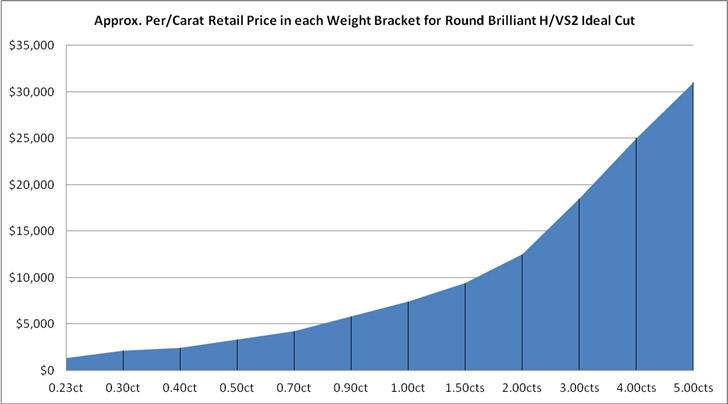4C'S LEARNING CENTER
Be confident you're getting the best diamond for your money. Here you'll find unbiased information to help take the anxiety
out of this exciting time. We don't buy or sell diamonds and we don't get commissions for recommending certain retailers.
Be confident you're getting the best diamond for your money. Here you'll find unbiased information to help take the anxiety out of this exciting time. We don't buy or sell diamonds and we don't get commissions for recommending certain retailers.
HOW THE 4C'S AFFECT PRICE
The 4C's - carat weight, cut, color and clarity - are the foundation for assessing and valuating diamonds. Because diamonds are so precious and rare, any slight variation in carat, cut, color and or clarity will have a significant impact on price.
If you're diamond shopping then you probably already have a budget in mind. Of course you want to get the best diamond for your buck, but how do you decide the best combination of the 4C's? If you choose one color grade higher or lower on the scale, how will it affect your wallet? Read on.
The 4C's - How DIAMOND SHAPE affects value
The shape of a diamond affects the value because some shapes inherently yield a better weight retention percentage from the rough material. In other words, some shapes more closely follow the natural
rough diamond form and therefore don't waste as much material during the cutting process. Faceted diamonds typically weigh 40%-60% of their original rough weight.
Supply and demand also play a part in how shape affects the value of a diamond. Rounds are the most popular and most costly shape. In addition, round brilliants require the most amount of skill and time to cut properly.
Generally speaking, when comparing diamonds of equal size and quality, rounds are the most expensive shape followed by Heart, Oval, Asscher, Pear & Marquise and then Emerald, Radiant, Cushion & Princess.
The price difference between rounds and princesses can be as little as 0-20% in lower colors and clarities, and as great as 100% in larger sizes and higher colors and clarities.
The 4C's - How CARAT WEIGHT affects value
Carat weight is the simplest value factor to understand. The larger the diamond, the more it costs, assuming all other factors are equal.
Per carat
Diamonds are priced on a per carat basis, which ranges greatly depending on the quality.
Calculate the price per carat to compare the cost of similar diamonds. Divide the selling price by the exact carat weight to determine the price per carat. For example, a 1.07 carat diamond that sells
for $8,560 has a per carat price of $8,000 ($8,560 ÷ 1.07 = $8,000).
Exponential increases
Large diamonds are rarer than small diamonds; therefore, the price disproportionately increases as the carat weight increases. The cost of a 2-carat diamond is much greater than twice the cost of the
same quality 1.00 carat diamond. A ring made of many small diamonds totaling 1-carat will most certainly cost less than a ring with a solitaire 1-carat diamond.
Price brackets
While diamond prices per carat go up exponentially compared to the weight, these increases occur in steps. This is because diamonds are traded on the wholesale level according to pricing guides that
state per/carat values in weight ranges or brackets.
As an example, let's look at a the price of a 0.98ct vs. 1.02ct, both Round Brilliant H/VS2 Ideal Cut:
Per carat retail price for 0.90-0.99ct range is approx. $6,425, which makes the selling price of the 0.98ct = $6,296
Per carat retail price for 1.00-1.24ct range is approx. $7,590, which makes the selling price of the 1.02ct = $7,742
Big difference for something you can't see.
But buyer be warned, it's difficult to find diamonds that weigh just below the price/carat step increase because cutters want to maximize the value of their goods.

The 4C's - How COLOR affects value It is difficult for an untrained eye to see the difference between each individual letter grade, but most people can easily see the distinction between diamonds of a few grade differences, such an E and an H or an H and a K, especially when compared side by side. Color differences are most noticeable when diamonds are next to one another. Keep this in mind when purchasing loose diamonds that will be set next to one another in a piece of jewelry. Make sure they are similar colors - not more than 2-3 grades different.
The price difference between each color grade (all else being equal) ranges from about 3% to more than 25%. The price increments increase when the other quality factors are higher. For example, the difference between each color grade for a 1.00 carat VS1 clarity diamond is about 10-15% per color grade, whereas the difference between each color grade for a 1.00 carat SI2 clarity diamond is about 3-7% per color.
Color is more noticeable in larger diamonds and in diamonds with fewer facets such as Emerald and Assscher cuts, and, color is less noticeable in well cut diamonds and in diamonds with more facets such as Round and Princess cuts.





